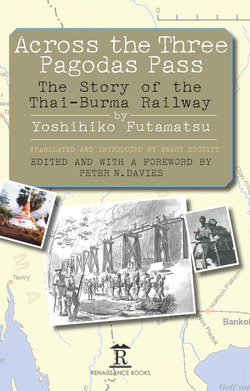Читать книгу Across the Three Pagodas Pass - Yoshihiko Futamatsu - Страница 14
На сайте Литреса книга снята с продажи.
ОглавлениеChapter 1
DEPARTURE FOR THE FRONT
The policy of continuing the war between China and Japan was not approved by America and, with their anti-Japanese freezing of assets as well as of oil in the southern zone, our country was increasingly under coercion. Diplomatic relations between Japan and America becoming difficult, secret preparations were pushed ahead in case by any chance it came to war. So far as we knew at the time diplomatic negotiations between Japan and America were believed to be succeeding.
Gunzoku, civilian auxiliaries of Japanese nationality, were called up nation-wide, higher management, junior management and other employees according to the district where they were born. Special Railway Bridge Unit was formed of gunzoku, as an auxiliary of a railway regiment. In the battle-zone, a railway regiment’s role was to work on the enemy’s railway lines and to administer the rear organization. In the event of an outbreak of war in the southern war theatre (to which we suspected we were due to join, being equipped with light summer clothing) the whole force to which we were attached had a complement of about 2,000 men. I was attached to unit HQ and in addition to me there were thirteen gunzoku senior officials in the four working companies. There were about seventy junior officials of NCO rank and altogether about 500 gunzoku were attached to the HQ and working companies. The unit was due to be sent to the Malayan front as a part of the Expeditionary Force with the Imperial Guard Division, who were nick-named ‘Miya’. Junior officials wore swords at the hip but ordinary employees had side-arms only and did not have rifles. Because we gunzoku for the most part had no experience of military training (the junior officials did not even know how to salute) we were all at sea and confused.
In the afternoon of 24 October our transport, the Hakuroku maru, slipped her moorings in the port of Ōsaka. She passed through the Straits of Shimonoseki, moving out to the open sea and that evening passed in the offing at the western tip of Kyūshū through the chain of five islands and we saw from the ship the last trace of Japanese land like the shadow of a sea-borne bird. No-one would have believed that we were to live abroad for over five years. We had contracted at our enlistment for repatriation every two years.
We entered some part of the South China Sea, seas became rough, and the ship tossed about left and right as if she were tipsy. In heavy seas the convoy ships which formed our fleet went out of sight. We passed close to Taiwan and began to feel hot. Our ship was heading for the southern region.
